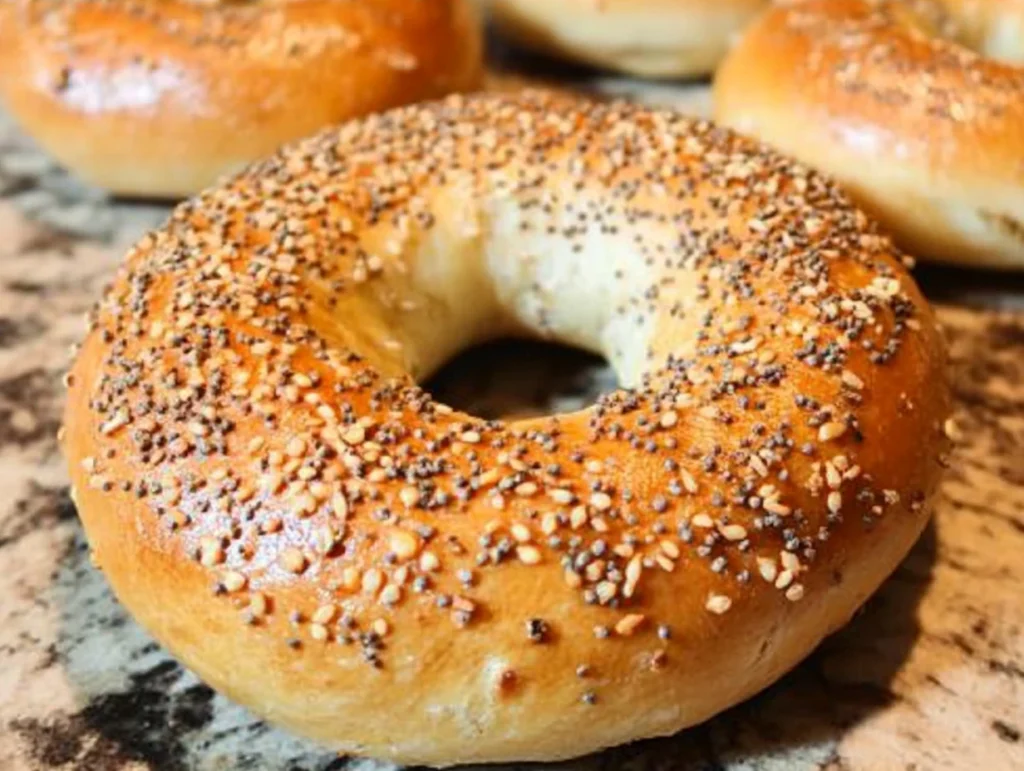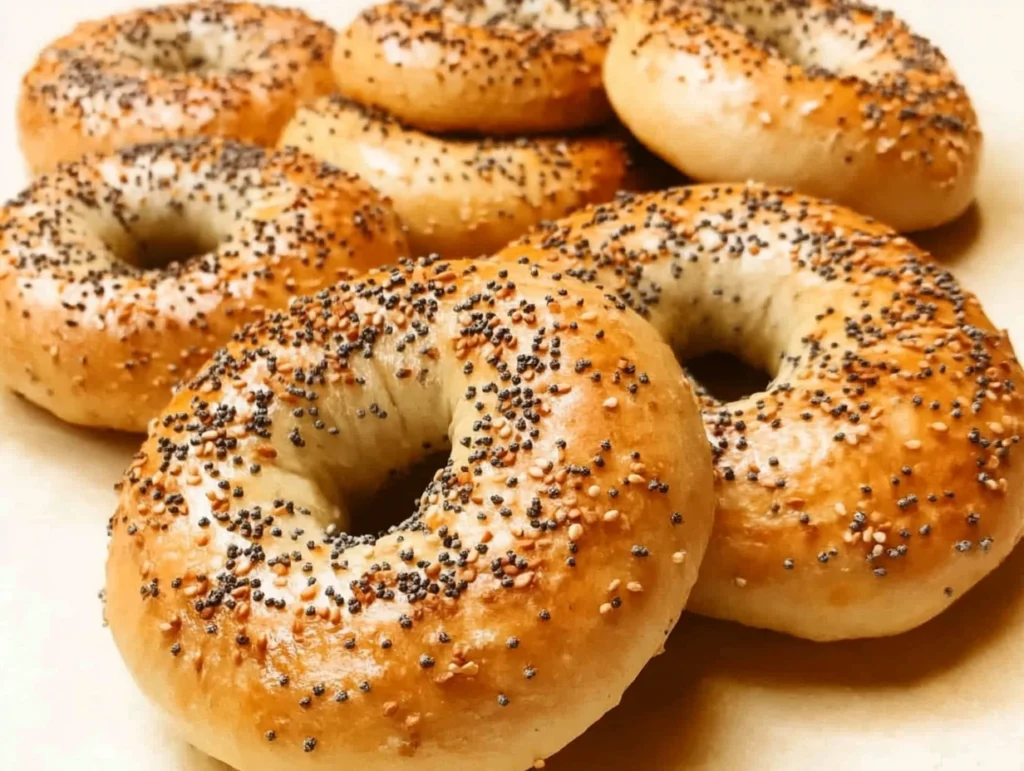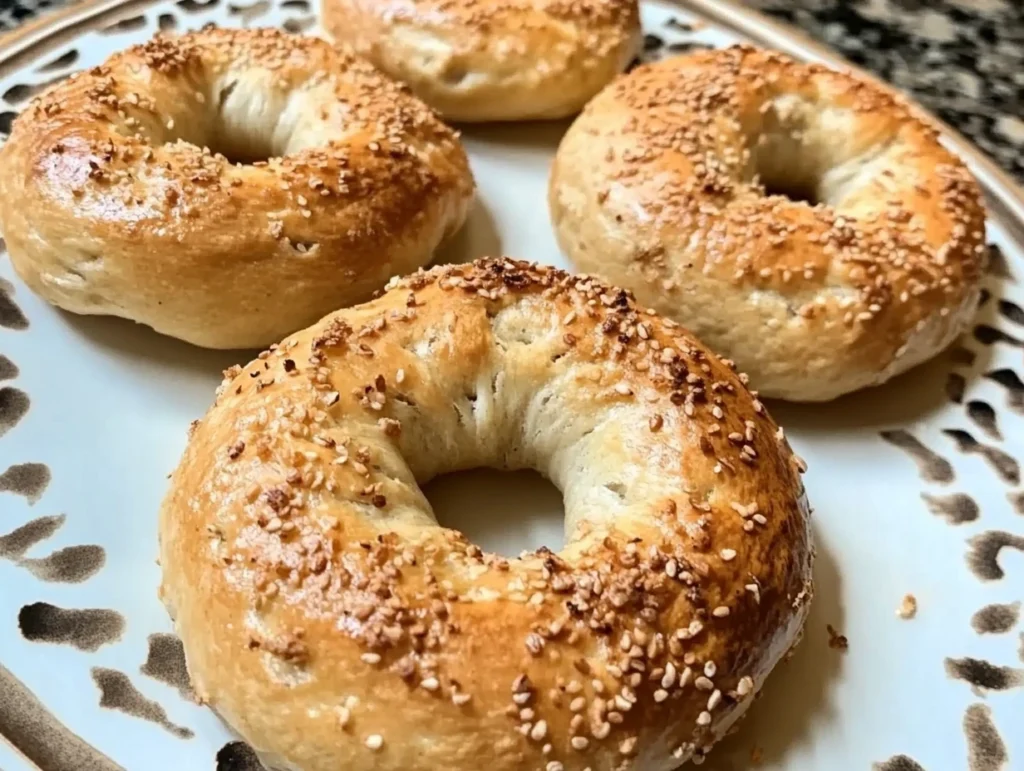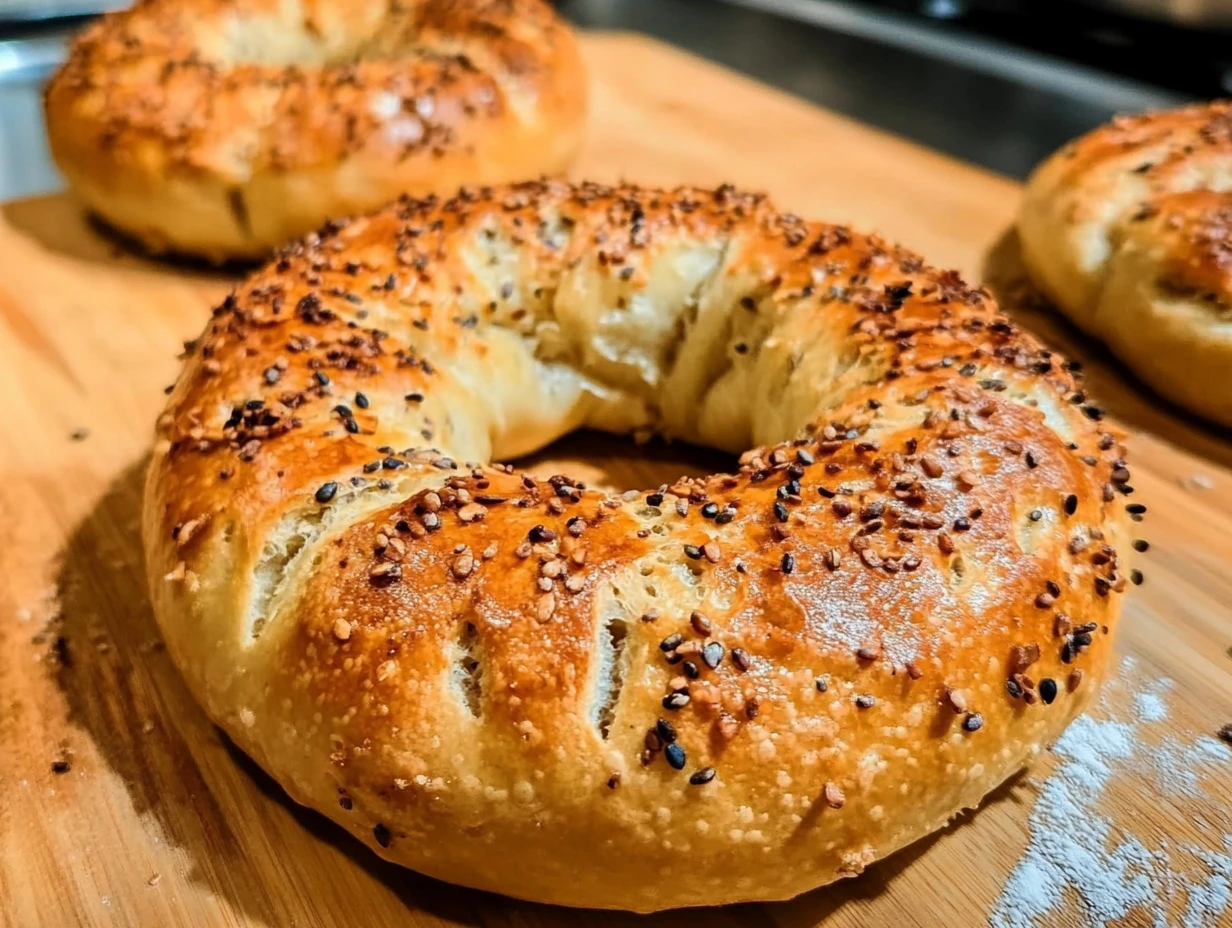Gluten-free bagels are a delicious alternative for those avoiding gluten due to dietary restrictions or lifestyle choices. They provide a chewy, flavorful experience without compromising on taste or texture. Homemade gluten-free bagels are versatile, easy to customize, and can fit various dietary needs.
Table of Contents
Why Make Your Own Bagels?
Making your own gluten-free bagels offers greater control over the ingredients, freshness, and taste. Additionally, it’s a rewarding culinary project that ensures you avoid processed additives found in many store-bought options.
Health Benefits of Gluten-Free Diets
For those with celiac disease or gluten sensitivity, following a gluten-free diet is essential to avoid digestive discomfort, inflammation, and other symptoms. Even for individuals without gluten intolerance, reducing gluten may contribute to improved digestion and reduced bloating. Homemade gluten-free bagels let you enjoy baked goods while aligning with a health-conscious lifestyle.
Comparing Homemade vs. Store-Bought Bagels
Store-bought gluten-free bagels are often convenient but can be expensive and packed with preservatives, artificial flavors, and excess sugar. In contrast, homemade bagels allow for customization with wholesome ingredients, better flavor, and a fresher product. Additionally, baking at home can be more cost-effective in the long run, especially for regular bagel enthusiasts.
Key Ingredients for Gluten-Free Bagels
The Role of Gluten-Free Flour
Gluten-free flour is the foundation of any gluten-free bagel recipe. Popular options include rice flour, almond flour, and sorghum flour. For the best texture and flavor, many recipes combine multiple types of gluten-free flours to mimic the elasticity and structure provided by gluten. Pre-mixed gluten-free flour blends often work well for convenience and consistent results.
Essential Binders: Xanthan Gum & Psyllium Husk
Since gluten is what gives traditional bagels their chewy texture, binders like xanthan gum or psyllium husk are crucial. Xanthan gum helps hold the dough together and provides elasticity, while psyllium husk adds moisture and mimics gluten’s stretchiness. Together, these ingredients ensure your bagels hold their shape and have a satisfying chew.
Sweeteners and Flavor Enhancers
Sweeteners such as honey, maple syrup, or sugar are often added to bagel dough to enhance flavor and aid in browning. Additionally, salt balances the sweetness and enriches the overall taste. For variety, spices, herbs, or seeds like cinnamon, garlic, or sesame can be added to create unique flavors.

Equipment You’ll Need
Must-Have Tools for Perfect Bagels
- Mixing Bowls: For combining ingredients and kneading the dough.
- Stand Mixer or Hand Mixer (Optional): To make mixing easier, especially for dense gluten-free dough.
- Baking Sheet with Parchment Paper: Ensures even baking and prevents sticking.
- Pot for Boiling Water: Bagels need a quick boil to create their signature crusty exterior.
- Slotted Spoon or Spider Strainer: For removing bagels from the boiling water.
Optional Accessories
- Bagel Mold or Cutter: To create uniform shapes with ease.
- Silicone Baking Mat: A reusable and non-stick alternative to parchment paper.
- Kitchen Scale: For precise measurements, especially when working with gluten-free ingredients.
- Pastry Brush: To apply egg wash for a glossy finish before baking.
Step-by-Step Recipe Instructions
Preparing the Dough
- Combine Dry Ingredients: In a large mixing bowl, whisk together your gluten-free flour blend, xanthan gum or psyllium husk, salt, and any additional dry ingredients like sugar or spices.
- Activate the Yeast: In a separate bowl, dissolve active dry yeast in warm water with a teaspoon of sugar. Let it sit for 5-10 minutes until it becomes frothy.
- Mix the Dough: Slowly combine the yeast mixture with the dry ingredients. Add any wet ingredients like oil, honey, or eggs if the recipe calls for them. Mix until a sticky dough forms.
- Knead: Using a stand mixer with a dough hook or your hands, knead the dough until smooth. Gluten-free dough may feel stickier than traditional dough, but avoid over-kneading.
- Rest the Dough: Cover the dough with a clean towel and let it rise in a warm place for about 1 hour or until it doubles in size.
Shaping the Bagels
- Divide the Dough: Once the dough has risen, lightly flour your hands and divide it into equal portions (about 6-8, depending on the size of your bagels).
- Shape the Bagels: Roll each portion into a ball, then poke a hole in the center using your finger. Gently stretch the hole until it’s about 1-2 inches wide, as it will shrink during cooking.
- Prepare for Boiling: Place the shaped bagels on a parchment-lined baking sheet and let them rest for 10-15 minutes.
Boiling and Baking
- Boil the Bagels: Bring a pot of water to a gentle boil and add a tablespoon of honey, sugar, or baking soda (this helps create a glossy crust). Boil each bagel for about 30 seconds on each side, then transfer them back to the baking sheet.
- Apply Toppings: Brush the boiled bagels with an egg wash or oil and sprinkle with desired toppings like sesame seeds, poppy seeds, or coarse salt.
- Bake: Preheat your oven to 400°F (200°C). Bake the bagels for 20-25 minutes or until they are golden brown and firm. Allow them to cool slightly before serving.
Tips for the Best Gluten-Free Bagels
Common Mistakes to Avoid
- Using the Wrong Flour: Not all gluten-free flours behave the same way. Stick to a trusted blend or recipe-specific flour recommendations.
- Skipping Binders: Never omit xanthan gum or psyllium husk, as they are essential for structure and texture.
- Overmixing the Dough: Overmixing can make the dough too dense or dry, which impacts the final product.
- Rushing the Rising Process: Gluten-free dough needs time to rise properly. Be patient for the best results.
How to Achieve the Perfect Texture
- Use the Right Boiling Technique: Boiling the bagels in water with added sugar or baking soda is key for a chewy crust and glossy finish.
- Don’t Skip Resting Time: Letting the bagels rest before boiling and baking ensures they maintain their shape.
- Add Moisture: Gluten-free dough can dry out quickly. Use wet ingredients like eggs, honey, or yogurt to keep it moist and pliable.
Flavor Variations and Toppings
Savory Options
- Everything Bagels: Sprinkle a blend of sesame seeds, poppy seeds, dried garlic, dried onion, and coarse salt before baking.
- Herb and Garlic: Mix fresh or dried herbs like rosemary, thyme, or chives into the dough, and add minced garlic for extra flavor.
- Cheesy Delight: Top with shredded cheddar, Parmesan, or mozzarella before baking for a cheesy crust.
- Sun-Dried Tomato and Basil: Fold chopped sun-dried tomatoes and fresh basil into the dough for a Mediterranean-inspired bagel.
Sweet Ideas
- Cinnamon Raisin: Mix cinnamon and raisins into the dough for a warm, sweet flavor. Sprinkle extra cinnamon sugar on top before baking.
- Blueberry Bagels: Fold dried or fresh blueberries into the dough for a fruity twist.
- Chocolate Chip: Add mini chocolate chips to the dough for a decadent treat.
- Maple Pecan: Incorporate chopped pecans into the dough and drizzle maple syrup over the tops before baking.
Creative Toppings
- Avocado and Microgreens: Spread mashed avocado on a bagel and top with microgreens or sprouts for a fresh, healthy option.
- Spicy Kick: Sprinkle red pepper flakes or chili powder on the bagel tops for a touch of heat.
- Nut Butter and Banana: Spread almond or peanut butter on your bagel and top with banana slices for a sweet, protein-packed snack.
- Vegan Cream Cheese and Dill: Spread vegan cream cheese on the bagel and garnish with fresh dill or capers for a plant-based option.

Storage and Reheating Tips
How to Keep Bagels Fresh
- Short-Term Storage: Store bagels in an airtight container or a resealable plastic bag at room temperature for up to 2 days. Avoid refrigerating them, as this can dry them out.
- Moisture Maintenance: Place a paper towel in the storage bag to absorb excess moisture and prevent sogginess.
Freezing and Reheating
- Freezing: Allow bagels to cool completely, then wrap each one in plastic wrap and place them in a freezer-safe bag. Freeze for up to 3 months.
- Reheating: To reheat, thaw the bagels at room temperature, then toast them for a crispy exterior. Alternatively, wrap them in foil and warm in an oven at 350°F (175°C) for 10 minutes.
Serving Suggestions
Pairing with Breakfast Dishes
- Classic Spread: Serve with cream cheese, butter, or jam.
- Egg and Cheese: Pair your bagel with scrambled eggs, cheese, and avocado for a hearty breakfast.
- Smoked Salmon: Create a classic bagel and lox with smoked salmon, cream cheese, capers, and red onions.
- Yogurt and Fruit: Enjoy a sweet bagel alongside a bowl of yogurt and fresh fruit for a balanced morning meal.
Turning Bagels into Sandwiches
- Lunch Sandwiches: Use bagels to make a deli-style sandwich with turkey, ham, or chicken and your favorite condiments.
- Vegetarian Options: Add hummus, grilled veggies, and spinach for a plant-based bagel sandwich.
- Burger Base: Swap out burger buns with bagels for a unique twist on a classic burger.
- Pizza Bagels: Slice bagels in half, add marinara sauce, mozzarella cheese, and toppings, then bake until bubbly.

FAQs About Gluten-Free Bagels
Can I use any gluten-free flour blend?
Not all gluten-free flour blends are created equal. Some blends are formulated for specific recipes and may not work well for bagels. Look for a blend that includes a mix of rice flour, tapioca starch, and potato starch, as these mimic the structure of traditional flour. Avoid blends with coconut flour or almond flour unless specified in the recipe, as they can alter the texture.
Why are my bagels too dense?
Dense bagels can result from:
- Overmixing or undermixing the dough, which affects its structure.
- Skipping the resting or rising time, preventing proper air development.
- Using too much flour, which can dry out the dough.
To fix this, ensure the dough is well-kneaded and given enough time to rise, and measure flour accurately.
Do I need to boil gluten-free bagels?
Yes, boiling is a critical step for bagels, including gluten-free ones. It creates a crusty exterior while locking in moisture for a chewy interior. Boiling water with honey, sugar, or baking soda enhances the bagel’s flavor and helps achieve the glossy finish. Skipping this step may result in bagels that are more bread-like.
How long do homemade bagels last?
Homemade gluten-free bagels stay fresh for:
- Room Temperature: Up to 2 days in an airtight container or resealable bag.
- Freezer: Up to 3 months if wrapped and stored properly.
Since gluten-free baked goods can dry out quickly, it’s best to consume them fresh or freeze them shortly after baking.
Can I make bagels without xanthan gum?
Yes, but you’ll need an alternative binder. Psyllium husk is a great substitute and can add elasticity and moisture to the dough. Chia seeds or flaxseeds mixed with water (to form a gel-like consistency) can also work in some recipes. Keep in mind that the texture may vary depending on the substitute used.
What toppings work best for gluten-free bagels?
Popular toppings for gluten-free bagels include:
- Savory: Everything seasoning, sesame seeds, poppy seeds, garlic flakes, or shredded cheese.
- Sweet: Cinnamon sugar, maple glaze, or a drizzle of honey.
- Custom Options: Try fresh herbs, chili flakes, or nutritional yeast for unique flavors.
Always brush your bagels with egg wash or oil before baking to help the toppings adhere properly.
- When discussing flavor variations and toppings for bagels, you could link to the article on Homemade Blueberry Bagels to guide readers to specific recipes for sweet bagel options.
- In your savory toppings section, mention bagel chips as a creative use of leftovers and link to the article Homemade Bagel Chips Recipe for additional inspiration.
- For readers looking to pair bagels with complementary dishes, you could link to breakfast options like Applesauce Pancakes: Ultimate Breakfast Guide to suggest meal combinations.
- When discussing gluten-free alternatives, direct readers to Chicken Slow Cooker Recipes: Gluten-Free to explore more gluten-free meal ideas.
- In the section on sweet bagel ideas, you can link to recipes like Homemade Cinnamon Raisin Bagels for readers who love warm, spiced flavors.
Conclusion
Homemade gluten-free bagels offer a delightful way to enjoy fresh, chewy bagels without compromising dietary needs or flavor. By using the right combination of ingredients, tools, and techniques, you can create bagels that rival (or even surpass) store-bought options in taste and quality. Whether you prefer savory toppings, sweet variations, or unique creations, making your own bagels allows for endless customization. Plus, the process is both rewarding and fun!

